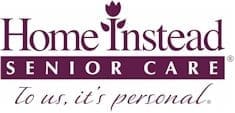Arming Family Caregivers with Resources for Healthy Eating
We all know healthy eating is important for people of all ages. But eating a well-balanced diet is especially essential for seniors who want to feel their best. Unfortunately, problems associated with aging can interfere with some seniors’ ability to maintain a healthy diet.
“We see seniors every day whose health is affected by poor diet, multiple medications and illnesses,” says Kristi Campbell, local Home Instead franchise owner. “Additional challenges to eating well can include loss of appetite, memory problems, dental health and use of certain medications.”
So what should family caregivers look for to signal that their loved one may not be eating properly? Here are some of the most common signs:
| ⦾ Loss of appetite. |
| ⦾ Little to no interest in eating out. |
| ⦾ Depression. |
| ⦾ Sudden weight fluctuation. |
| ⦾ Expired or spoiled food. |
| ⦾ Skin tone. |
| ⦾ Lethargy. |
| ⦾ Cognitive problems. |
| ⦾ More than three medications. |
| ⦾ A recent illness. |
“Without good nutrition, health can deteriorate very quickly, making seniors more susceptible to disease and infection,” says Dr. Nadine Sahyoun, Associate Professor of Nutrition and Food Science at the University of Maryland. “Without intervention, malnutrition can lead to poor health and even death,” she warns.
Social support and assistance in shopping and preparing meals are the essential ingredients many older adults need in order to eat a healthy diet. This help may come in the form of a family or professional caregiver, taking part in a congregate meal program, such as those offered at senior centers, or contracting for a home delivery program, such as Meals on Wheels.
Experts also tell us that older adults may find they can’t eat as much as they used to, but their needs for vitamins and minerals can increase. Therefore, it becomes even more important for seniors to eat nutritious foods. National nutrition experts have helped us to identify 12 nutritious foods to consider including in a healthy diet: Oatmeal, Eggs, Yogurt, Blueberries, Apples, Fish, Chicken, Broccoli, Soy,
Sweet Potatoes and Squash, Rice, and Dark Chocolate.
Since caregivers can play a vital role in ensuring their loved ones’ healthy eating habits, nutrition experts offer some tips to make that job a little easier:
| ⦾ | Get organized and make a shopping list. |
| ⦾ | Buy fresh ingredients and prepare meals with your loved ones, enticing them with what they like to eat. It’s easy to get in a rut, so bring in new recipes and ingredients. |
| ⦾ | Make eating a happy event. Sometimes we focus too much on what people can’t eat and don’t give enough attention to what food represents to us. Food is at the core of our lives – it’s the smell, color, feel, texture and social aspect. We have to pay attention to those things. |
| ⦾ | Companionship is vital to making mealtime more engaging for an older adult, so enjoy your meals together. |
| ⦾ | Sign up for meals at a senior center or meal delivery program, and enlist the help of a paid companion. Encouraging older adults to develop good habits will keep them healthy and give family caregivers peace of mind. |
These resources should provide family caregivers with the tools and information they need to improve the nutritional lives of their seniors and head off a crisis by tuning into the early signs of trouble.
Submitted by Kristi Campbell, Local Hillsborough County Home Instead Franchise Owner
1,2,3. The Boomer Project (www.boomerproject.com) completed online interviews with 1,279 U.S. adult caregivers, ages 35-62, with a parent, stepparent or older relative for whom they or someone in their household provides care. Questions regarding nutritional risk factors and stress adapted from Abbott Laboratories’ “Determine Your Nutritional Health” checklist. Used with the permission of Abbott Laboratories, copyright 2008.

